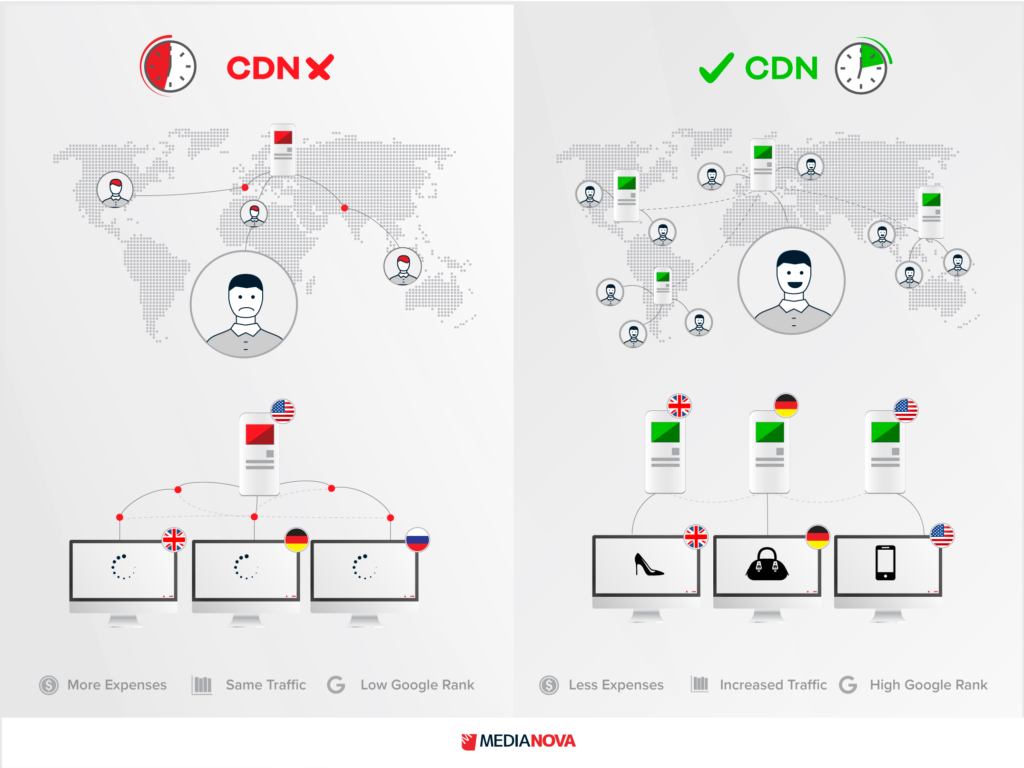What is X-CDN Header?
To answer the question that what is X-CDN Header, we should identify a few keywords; CDN and HTTP.
CDN
Through its geographically dispersed design, Content Delivery Network (CDN) is a cloud computing solution that allows websites and Over-the-top (OTT) material to be transferred from the closest places. This service reduces the time it takes to respond to requests from online platforms that serve a variety of functions, such as e-commerce, gaming, and video.
Today, CDNs bear the brunt of the bulk of global internet traffic. CDNs provide access to a vast number of websites and platforms, which helps decrease downtime and improve user speed.
In recent years, the Internet has become so global have 24/7 content requests worldwide.
Although they improve the end-user experience ultimately, Content Distribution Networks’ primary customers are website or platform owners. Because of the numerous benefits, it provides to businesses, Content Delivery Network service is widely used.
A CDN can be a great solution for your business, especially if you serve customers or clients all around the world. Today, CDNs bear the brunt of the bulk of global internet traffic. CDNs provide access to a vast number of websites and platforms, which helps decrease downtime and improve user speed.

HTTP
The Hypertext Transfer Protocol (HTTP) is an application-level protocol for hypermedia information systems that are dispersed and collaborative. Since 1990, this has served as the foundation for data transfer on the World Wide Web (i.e. the internet).
HTTP resources, such as web servers, are recognized throughout the Internet by using Uniform Resource Locators (URLs) which are unique identifiers.
HTTP is a flexible and stateless protocol that may be modified to serve new functions by adjusting its request methods, error codes, and headers. HTTP follows a request-response paradigm, in which the client makes a request and the server responds with not only the requested content, but also pertinent request status information. This self-contained architecture accommodates the Internet’s dispersed nature, in which a request or answer may traverse through numerous intermediary routers and proxy servers.
It also enables intermediary servers to provide value by performing activities like as load balancing, caching, encryption, and compression.
HTTP is an application-layer protocol that functions by relying on an underlying network-layer protocol such as Transmission Control Protocol (TCP).
Information is sent between clients and servers in the form of Hypertext documents, which is where the name HTTP comes from. Hypertext is structured text that employs logical links or hyperlinks, to connect text-containing nodes. Hypertext Markup Language (HTML) allows you to edit hypertext documents. Clients can request various types of material (such as text, images, video, and application data) from web and application servers that host the information using HTTP and HTML.

X-CDN is an HTTP header which is the name describing the CDN being used.
X-CDN – This is a special header that you must include in all replies from your CDNs. The value of this should be a name that describes that particular Content Delivery Network.
Access-Control-Expose-Headers – This should be set on each response with a comma-separated string of headers to expose to the client. At the very least, this should be set to X-CDN. It is also recommended that you provide any other identifying headers that your Content Delivery Network may employ, such as X-Cache, X-Served-By, Via, or similar headers.
X-CDN HEADER USE CASE
Medianova CDN sends a large number of requests to the client’s origin server, and Medianova Content Delivery Network’s Internet Protocol (IP) addresses are sometimes blocked because multiple requests originate from the same IP address. They allow Medianova Content Delivery Network’s IPs, which is one way they don’t block IP’s, but on Content Delivery Network’s end, the IP pool is large and the number of new additions can be large. That is why it is preferable that they allow Content Delivery Network’s to pass through the header. Rather than defining a large number of IPs for their own firewalls and keeping track of their updates, allowing them over the X-CDN Header simplifies things for both parties.
In a nutshell, X-CDN Header serves as some sort of a key between Origin and CDN.
With its footprint in 21 countries and 100% SSD-powered anycast network, Medianova is one of the fastest HTTPS secure CDNs in Europe and the Middle East based on Cedexis.



